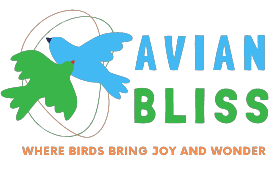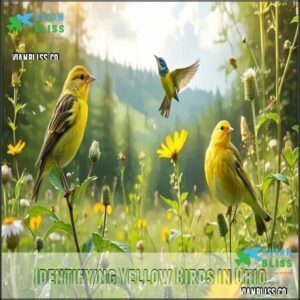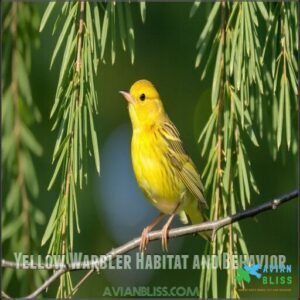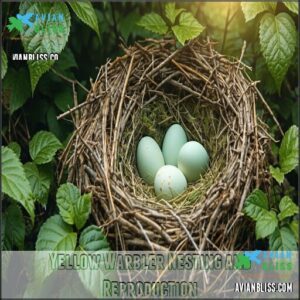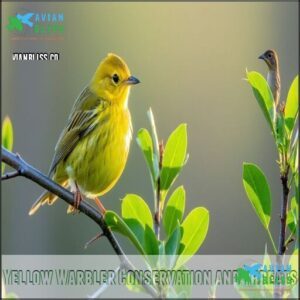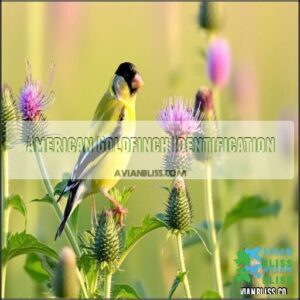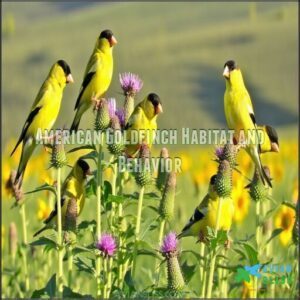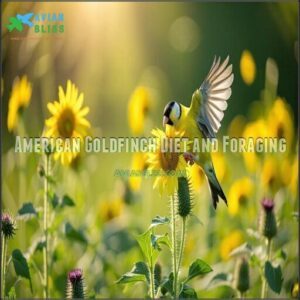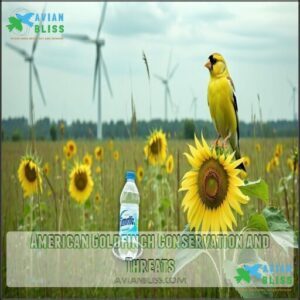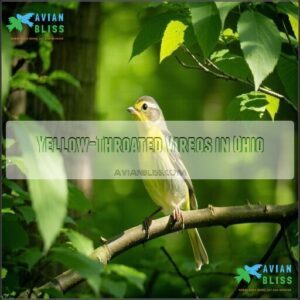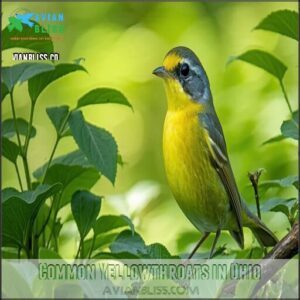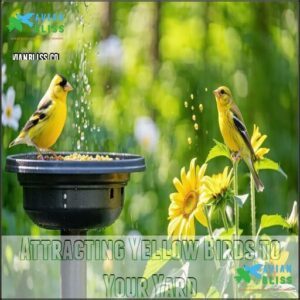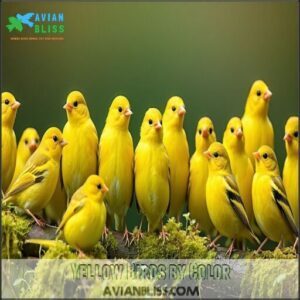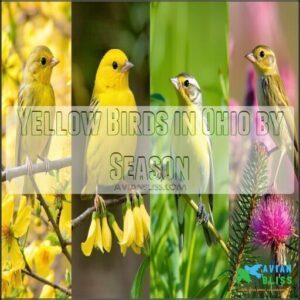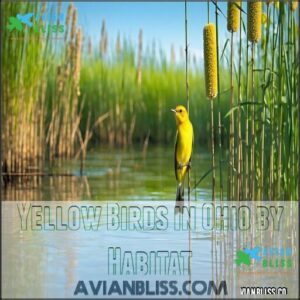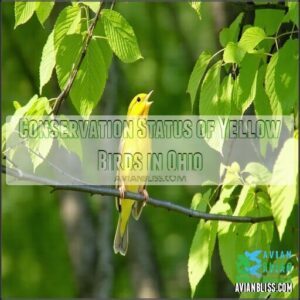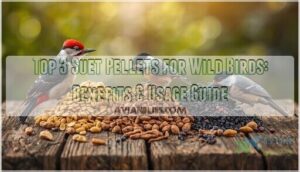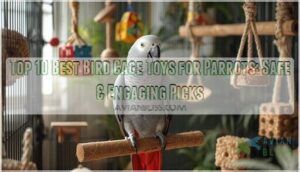This site is supported by our readers. We may earn a commission, at no cost to you, if you purchase through links.
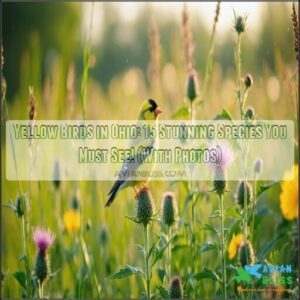
You’ll spot these feathered rays of sunshine in backyards, wetlands, and forests. The American Goldfinch, Ohio’s state bird, loves thistle feeders and open fields, while Yellow Warblers prefer to nest near water.
Keep an eye out for the Yellow-Throated Vireo, a small songbird with a bold personality. Each bird adds a splash of color and life to Ohio’s landscape, making birdwatching here a real treat.
Want to attract them? Try adding native plants or a water source.
Table Of Contents
- Key Takeaways
- Identifying Yellow Birds in Ohio
- Yellow Warblers in Ohio
- American Goldfinches in Ohio
- Yellow-Throated Vireos in Ohio
- Common Yellowthroats in Ohio
- Attracting Yellow Birds to Your Yard
- Yellow Birds by Color
- Yellow Birds in Ohio by Season
- Yellow Birds in Ohio by Habitat
- Conservation Status of Yellow Birds in Ohio
- Frequently Asked Questions (FAQs)
- How do I identify yellow birds in Ohio?
- Do yellow birds live in Ohio?
- Are yellow throated warblers spotted in Ohio?
- Which birds can you see in Ohio?
- What does a yellow bird look like in summer?
- What kind of birds are yellow in Ohio?
- What is the most common yellow bird?
- Are goldfinches in Ohio year round?
- What is the difference between yellow and goldfinch?
- How do you know if a bird is a yellow bird?
- Conclusion
Key Takeaways
- You’ll easily spot common yellow birds in Ohio like the American Goldfinch, Yellow Warbler, and Common Yellowthroat in backyards, wetlands, and forests.
- Attract yellow birds to your yard with native plants, thistle seed feeders, and clean water sources.
- Ohio’s yellow birds thrive seasonally—from bright American Goldfinches in summer to Yellow-rumped Warblers during winter.
- Habitat loss and climate change threaten yellow birds, but planting native vegetation and supporting bird conservation efforts can help.
Identifying Yellow Birds in Ohio
You’ll spot Ohio’s yellow birds by looking for their bright colors and unique markings, from the American Goldfinch’s black cap to the Common Yellowthroat’s distinctive black mask.
You can find these colorful visitors in habitats ranging from backyard feeders to wetlands and forest edges, where their seed-eating or insect-hunting behaviors will help confirm their identity.
Common Yellow Birds in Ohio
Ohio’s golden-feathered residents brighten yards and wild spaces year-round, making yellow birds some of the state’s most beloved wildlife sightings.
You’ll quickly recognize these common yellow birds in Ohio with a little practice.
Here are three yellow stunners you’ll commonly spot across the Buckeye State:
- American Goldfinch: These vibrant Ohio Goldfinches stay year-round, displaying bright lemon-yellow plumage with black caps and wings during summer, while adopting olive-brown winter colors.
- Yellow Warbler: Look for their entirely yellow bodies with subtle chestnut streaking on the chest, especially near water sources and forest edges.
- Common Yellowthroat: Instantly recognizable by the male’s distinctive black mask and bright yellow throat, these birds’ secretive Yellowthroat behavior includes skulking through dense vegetation.
Keep your backyard habitats stocked with native plants and appropriate feeders to attract these sunshine-colored visitors.
Rare Yellow Birds in Ohio
Hidden among Ohio’s woodlands, five rare yellow birds await your discovery.
The Prairie Warbler, with its tiger-striped belly, thrives in southern wooded habitats despite climate impacts.
Kentucky Warblers remain scarce in moist forests due to habitat loss.
Evening Grosbeaks dazzle with their shell-cracking beaks during winter accidental sightings.
Yellow-throated Vireos, rare breeders in hemlock ravines, represent potential range expansion.
These treasures make Ohio bird watching uniquely rewarding.
Yellow Birds by Season in Ohio
Throughout the year, yellow birds come and go across Ohio, offering you different viewing opportunities with each season.
The timing of your birdwatching adventures matters greatly when searching for these golden beauties.
- Spring arrivals bring American Goldfinches transforming into their bright breeding plumage
- Summer breeding season showcases Yellow Warblers singing their "sweet-sweet-sweeter-than-sweet" melodies
- Fall migration routes fill with Magnolia Warblers heading south through Ohio
- Winter residents include occasional Evening Grosbeaks visiting feeders during cold months
- Seasonal changes affect which yellow birds you’ll spot in your backyard
American Goldfinches remain year-round but switch from vibrant summer yellow to dull olive-brown in winter.
Yellow-throated Vireos arrive by mid-April and stay through summer, while Yellow-bellied Sapsuckers pass through during spring and fall migration.
Even in winter, you might spot a Pine Warbler at your suet feeder during a mild spell.
Yellow Birds by Habitat in Ohio
After following birds through Ohio’s seasons, you’ll notice how habitat shapes where you’ll find these yellow beauties.
Yellow birds distribute themselves across Ohio’s diverse landscapes, each species finding its perfect home.
In forests, you’ll spot Hooded Warblers in the understory and Yellow-throated Vireos in the treetops.
Wetland Yellow Birds include the striking Prothonotary Warbler nesting in tree cavities near water and Common Yellowthroats hiding in cattails.
These birds showcase Ohio’s avian diversity.
Your backyard can attract American Goldfinches with the right feeders, while urban areas support adaptable species like Yellow-rumped Warblers.
- Field Trip Strategy: Visit a mix of Ohio bird habitats in one day—start at a forest edge, continue to a wetland boardwalk, and finish in a meadow where Eastern Meadowlarks display their yellow underparts.
Yellow Warblers in Ohio
You’ll spot these bright yellow songbirds in Ohio’s moist forests and willow groves from April to October, where males sport distinctive black caps that make them easy to identify.
These small warblers weigh just 0.2-0.3 ounces and feast mainly on insects, making them valuable garden helpers when they visit your backyard.
Yellow Warbler Habitat and Behavior
Each spring, these bright bundles of sunshine make their home in Ohio’s damp thickets and willow groves.
You’ll find Yellow Warblers darting through wetland habits, singing their distinctive "sweet-sweet-sweeter-than-sweet" territorial calls.
They prefer stream-side vegetation but adapt to various habitats from brushy wetlands to shrubby fencerows.
Watch them perform quick, energetic hops while insect foraging among leaves, and consider their impressive ability to fly non-stop across the Gulf of Mexico during migration—a feat that is particularly remarkable given that these birds are lighter than an ounce and travel hundreds of miles over open water.
In winter, they leave for Central and South America.
Yellow Warbler Nesting and Reproduction
After watching Yellow Warblers in their habitat, you’ll be amazed by their nesting skills. These yellow birds of Ohio create remarkable cup-shaped nests in shrubs and saplings, usually 3-8 feet above ground.
The female handles most nest building, weaving grasses, plant fibers, and spiderwebs into a cozy home.
The reproductive cycle moves quickly in May:
- Females lay 3-6 greenish-white eggs with dark spots, completing clutches by mid-May
- Incubation lasts 11-12 days, with males bringing food to sitting females
- Newly hatched chicks weigh just 1/20 ounce, with light gray down
- Parents share fledgling care, with young leaving the nest after 9-12 days
Yellow warblers have a clever trick for dealing with cowbirds. If they spot a cowbird egg in their nest, they’ll often build a new nest directly on top, burying the parasite’s egg completely, which is a remarkable behavior and helps in protecting their young with a unique nesting strategy.
Yellow Warbler Diet and Foraging
Yellow Warblers dart through Ohio’s landscapes as tiny insect-hunting specialists, showcasing remarkable foraging techniques.
You’ll notice these bright birds employ six distinct hunting methods:
- Hovering mid-air to snatch flying insects
- Methodically searching leaf undersides for hidden caterpillars
- Performing acrobatic twists to catch moths and mosquitoes
- Gleaning insects from tree bark crevices
- Hunting low in shrubs during morning hours
- Supplementing with berries during late summer
Their diet consists primarily of caterpillars, beetles, and flies, with males and females often dividing territories to maximize their insect consumption.
Their dietary adaptations help control pest populations throughout Ohio’s diverse habitats.
Yellow Warbler Conservation and Threats
Despite their cheerful presence in Ohio’s wetlands, Yellow Warblers face significant conservation challenges.
These bright songbirds have experienced a concerning 20% population decline since 1966.
Brood parasitism by brown-headed cowbirds and destruction of riparian habitats pose the greatest risks.
The avian vampire fly (Philornis downsi) also threatens chick survival rates.
You can help protect these beloved birds by supporting conservation efforts focused on wetland protection, reducing pesticide use, and promoting native plant growth in your yard.
American Goldfinches in Ohio
You’ll easily spot American Goldfinches in Ohio year-round, with males sporting bright yellow feathers and black caps during summer while females show duller yellow colors without the cap.
These small, seed-loving birds often visit backyard feeders filled with thistle seeds, making them regular guests that bring a splash of sunshine to Ohio’s fields, forests, and suburban gardens, with their presence being a notable aspect of the state’s backyard feeders.
American Goldfinch Identification
The bright-feathered American Goldfinch stands out as Ohio’s sunshine-on-wings with its unmistakable appearance.
You’ll easily recognize these yellow finches by their seasonal costume changes throughout the year:
- Male plumage showcases brilliant lemon-yellow bodies with contrasting black caps and wings in summer
- Female plumage features softer, olive-yellow coloring without the distinctive black cap
- Winter plumage transforms both sexes into dull brownish-olive birds with black wings
- Molting patterns occur twice yearly, with dramatic changes between breeding and non-breeding seasons
- Distinguishing features include white wing bars, short notched tails, and conical seed-cracking beaks
At just 4-5 inches long, these tiny birds pack a colorful punch.
Their small size and undulating flight pattern create a roller-coaster effect as they bounce through Ohio’s skies.
When identifying yellow birds in Ohio, the American Goldfinch’s seasonal wardrobe change makes it a year-round delight for birdwatchers.
American Goldfinch Habitat and Behavior
Ohio’s American Goldfinches thrive in diverse landscapes across the state, making them one of your most reliable backyard visitors year-round.
These cheerful yellow birds adapt easily to various habitats, from weedy fields to suburban gardens.
Watch for these fascinating behavior patterns:
- Undulating flight style that resembles a roller coaster
- Formation of tight-knit social groups during non-breeding seasons
- Seasonal shifts between open country in summer and forest edges in winter
- Territorial displays where males perform elaborate aerial songs
You’ll commonly spot these delightful Ohio birds in brushy areas with scattered trees, especially near thistle-rich meadows.
American Goldfinch Diet and Foraging
American Goldfinches in Ohio showcase remarkable seed preferences that make them fascinating to observe.
These vibrant yellow finches are strict vegetarians, relying almost entirely on seeds for their diet.
You’ll spot them expertly extracting seeds from thistle, sunflower, and dandelion plants with their specialized beaks.
Their foraging behavior is quite acrobatic – they’ll hang upside-down from seedheads and perform balancing acts to reach their meals.
During winter feeding, they switch to buds and small seeds, frequenting backyard feeders stocked with Nyjer or sunflower seeds.
Their vibrant plumage helps in identifying the goldfinch, even when their colors are less bright in winter.
Their diet consists mainly of seeds, making them strict vegetarians, and they have a unique way of eating, including extracting seeds from various plants.
The vibrant plumage of the American Goldfinch is a key identifying feature, and their ability to hang upside-down while foraging is quite notable.
American Goldfinch Conservation and Threats
The American Goldfinch faces growing challenges, from habitat loss and pesticide impact to climate change and disease transmission.
Urban sprawl shrinks their weedy fields and thistle-rich spaces, while pesticides harm their food sources. Climate shifts disrupt seed availability, making survival tougher during winter months.
Pesticides and urban growth rob yellow birds of food and shelter, while climate changes make surviving harsh winters even harder.
Every backyard and feeder owner can play a part in bird conservation. Keep feeders clean to prevent disease, plant native wildflowers for natural food, and avoid pesticides. Even small actions, like keeping cats indoors, can shield these delicate birds from unnecessary risks.
Supporting bird conservation efforts is key to reversing declining bird population trends. By protecting bird habitat conservation areas, you’re helping the American Goldfinch thrive across Ohio’s changing landscape. Together, we can create a safer future for these birds, and reversing declining trends is crucial for their survival.
Yellow-Throated Vireos in Ohio
You’ll love spotting Yellow-Throated Vireos in Ohio, especially during the warmer months when their bright yellow plumage stands out.
These woodland songbirds often perch high in trees, singing their cheerful, burry tunes while hunting small insects.
Yellow-Throated Vireo Identification
When you’re exploring Ohio’s woodlands, the Yellow-throated Vireo is an unforgettable sight. Known for its stunning plumage details, it showcases a bright yellow throat, olive-green back, and bold white "spectacles" around its eyes.
These Ohio birds stand out among other warblers in Ohio, making bird identification a true delight.
Here are key bird field marks to watch for:
- Distinctive white wing bars set against olive-yellow feathers
- A short, rounded bill perfect for catching insects mid-air
- Song recognition—a clear, melodic “here-I-am, see-me?”
The Yellow-throated Vireo might resemble the Yellow-throated Warbler, but subtle habitat clues can help distinguish them. Spotting this vireo is a joy for passionate birdwatchers!
Yellow-Throated Vireo Habitat and Behavior
The Yellow-Throated Vireo is a champion of Ohio’s mature oak woodlands, where it thrives high in the forest canopy. Its preferred habitat includes shaded branches perfect for foraging behavior, as it skillfully hunts insects with precision.
Known for their burry vocalizations, these lively birds brighten your spring walks. While social interactions are limited, their bold song marks territory.
Here’s a quick guide:
| Preferred Habitat | Nesting Habits | Foraging Behavior |
|---|---|---|
| Mature oak woodlands | Builds suspended nests | Hunts insects in treetops |
| Forest canopy living | Uses plant fibers | Targets hidden prey |
| Spring arrival sights | Territorial singing | Strategic midair catches |
Yellow-Throated Vireo Diet and Foraging
Yellow-throated vireos are fascinating little hunters that make the most of Ohio’s forests.
Their foraging strategies are agile and efficient, built to match their environment and needs. These yellow birds of Ohio primarily rely on protein-rich insects but will happily add fruits and berries when the seasons or habitats shift.
Here’s how they find their food:
- Aerial Hunting: Spot flying bugs, then snatch them in quick, midair ambushes.
- Bark Probing: Search tree trunks and branches for juicy insects hiding in cracks.
- Leaf Gleaning: Cling to leaves, flipping upside-down to pluck caterpillars or larvae.
Yellow-throated vireos embrace variety, adjusting prey selection to maintain their energy needs. Similar to the white eyed vireo, they’re insectivorous.
Yellow-Throated Vireo Conservation and Threats
When the cheerful call of Yellow-throated Vireos becomes rare, it’s a sign these striking songbirds are facing challenges.
Habitat Loss from Forest Fragmentation is reducing their breeding areas, while Climate Change disrupts their migration patterns.
Nest Predation by Brown-headed Cowbirds and collisions with glass buildings add to their struggles.
Pollution and Insecticide Use also interfere with their food chain, threatening survival.
Protecting these yellow birds in Ohio starts with bird conservation strategies.
Efforts like forest restoration, bird-safe infrastructure, and bird habitat protection are key.
By supporting Ohio bird conservation groups or planting native trees, you help keep these vibrant Ohio birds singing.
Small changes—for them—bring balance back to the forests we all cherish, through forest restoration and conservation.
Common Yellowthroats in Ohio
You’ll often spot Common Yellowthroats darting through Ohio’s wetlands, their cheerful yellow plumage and black masks easy to recognize.
These tiny warblers thrive in marshy thickets, where they hunt insects and belt out their distinctive “witchity-witchity” song.
Common Yellowthroat Identification
In the realm of yellow birds, Ohio boasts the vibrant and unmistakable Common Yellowthroat, a small warbler that’s easy to spot if you know what to look for.
These 4.3–5.1-inch gems are hard to miss. The male’s black mask gives it the look of a feathered superhero, while its bright yellow underparts pop against green wetlands.
Here’s how to identify this stunning bird:
- Black Mask: A bold feature on males, contrasting with their yellow throat.
- Yellow Underparts: Vibrant and eye-catching from any angle.
- Habitat Clues: Seen near marshes, overgrown fields, and thickets.
- Vocalizations: Listen for their cheerful “witchety-witchety” song.
- Similar Species: Unlike other small yellow birds or warblers, their mask and melody stand out.
Spotting a Common Yellowthroat makes any Ohio birdwatching trip unforgettable!
Common Yellowthroat Habitat and Behavior
Darting through Ohio’s marsh habitats, the Common Yellowthroat is full of energy and personality.
These spunky yellow birds thrive in wetlands where dense cattails and shrubs provide perfect hiding spots.
Here’s what makes their behavior fascinating:
- Territorial Behavior: Males boldly declare their turf with a sharp, repetitive “witchety-witchety-witch” song, tirelessly fending off intruders.
- Nest Locations: They craft cup-shaped nests close to the ground, cleverly camouflaged in thick vegetation to protect their young.
- Social Dynamics: Pair bonding is lively, full of playful chases and constant chatter that seem almost theatrical.
Catch them flitting and calling near water.
Their striking black masks and bright yellow bodies make even fleeting sightings memorable.
Get ready to meet one of Ohio’s most charismatic wetland dwellers!
Common Yellowthroat Diet and Foraging
Common Yellowthroats are talented hunters, turning their knack for catching insects into a daily spectacle.
You’ll find these yellow birds in Ohio prowling through wetlands and dense shrubs, where their quick moves are a joy to watch.
Their diet is rich in insect consumption, including beetles, caterpillars, and grasshoppers, but they occasionally snack on seeds and berries, showcasing their adaptability.
The seasonal diet shifts slightly, depending on what’s available.
Here’s a quick look:
| Foraging Habitats | Prey Variety | Seasonal Foods |
|---|---|---|
| Wetlands, marshy edges | Beetles, grasshoppers | Seeds, berries in winter |
| Shrubby fields | Caterpillars, spiders | Insects dominate in summer |
| Overgrown meadows | Flies, small bugs | Fruits when insects are scarce |
Their hunting is a mix of skill and instinct—nature in motion.
Common Yellowthroat Conservation and Threats
Common Yellowthroats face uphill battles in Ohio’s rapidly changing landscapes.
These lively warblers, often spotted flitting through wetlands or tangled vegetation, confront numerous threats that impact their survival.
- Habitat Loss: Urban sprawl is shrinking wetlands, cutting into critical breeding grounds for these yellow birds Ohio birdwatchers treasure.
- Climate Change: Warmer temperatures throw off migration timing, while unpredictable weather disrupts nesting seasons.
- Nest Predation & Brood Parasitism: Brown-headed Cowbirds lay eggs in their nests, leaving the Common Yellowthroat to raise another species’ young.
You can help these resilient warblers by supporting wetland protection efforts, minimizing pesticide use, and creating native plant gardens.
Together, we can guarantee Ohio birdwatching includes the cheerful sight of Common Yellowthroats for years to come.
Attracting Yellow Birds to Your Yard
If you want to attract yellow birds to your yard, focus on creating a space that meets their needs for food, water, and shelter.
By using feeders with seeds they love, planting native flowers, and setting up a clean water source, you’ll soon have colorful visitors flocking in.
Bird Feeders for Yellow Birds
Looking to attract yellow birds to your Ohio yard? Start with the right bird feeders. Tube and mesh feeders filled with nyjer or black oil sunflower seeds are favorites of yellow finches like the American Goldfinch.
Place feeders 10-15 feet away from trees or shrubs for cover. Cleaning feeders weekly is key—fresh food keeps birds healthy and coming back.
Consider using specialized seed feeders to dispense the nyjer seeds effectively. Mixing seed types can draw a mix of yellow birds, adding variety to your backyard.
Consider squirrel-proof feeders to protect your offerings, as clever critters are often unwelcome visitors. With the right setup, your yard can become the go-to buffet for Ohio’s vibrant yellow feathered friends, and attract yellow finches like the American Goldfinch, by providing fresh food.
Native Plants for Yellow Birds
Bring yellow birds like the American Goldfinch and Yellow Warbler straight to your Ohio yard by planting native plants that double as food sources and homes.
They’re not just eye candy—they’re lifelines for local wildlife.
Here are five Ohio-native options to make your backyard irresistible:
- Sunflowers: These cheerful blooms provide seed sources perfect for goldfinches.
- Goldenrod: A winter must-have, offering seeds when food is scarce.
- Black-eyed Susan: Bright flowers that support bird biodiversity.
- Shrubby Cinquefoil: Gorgeous yellow blooms and insect habitats combined.
- Milkweed: A powerhouse for pollinators and nesting materials.
Consider purchasing Ohio native varieties to support local ecosystems.
Mix these into your landscape, and you’ll blend beauty with function, turning your yard into a thriving hub for Ohio birds.
Water Sources for Yellow Birds
To attract Ohio’s vibrant yellow bird species, water sources are just as important as bird feeders.
You’ll need to create a watering setup that’s safe, inviting, and practical for birdwatching.
Here’s a quick guide to building the perfect bird-friendly oasis:
- Pick Varied Bird Bath Types: Choose basins, shallow baths, or flowing fountains—these mimic natural water sources and appeal to yellow warblers, goldfinches, and others.
- Focus on Water Source Placement: Keep baths low but near shrubs to provide escape routes.
- Keep It Clean: Refresh water every few days and clean baths weekly to prevent algae.
Adding warm water in winter guarantees your yellow bird visitors stay hydrated year-round.
Consider purchasing a pre-made bird bath for easy installation.
Tips for Creating a Yellow Bird-Friendly Yard
Creating a welcoming yard for yellow bird species is easier than you think.
Blend native plantings like goldenrod or coneflowers with safe feeders offering nyjer seeds or sunflower hearts. Add water features like birdbaths for bathing and drinking.
Dense shrubs and small trees provide excellent nesting sites, while minimal pesticide use keeps their food healthy. Don’t forget to manage predator control—place feeders in open areas to keep sneak attacks at bay.
Here’s a helpful guide:
| Element | Benefits | Examples | Tips |
|---|---|---|---|
| Native Plantings | Food, shelter | Goldenrod, milkweed | Leave seedheads for winter food |
| Water Features | Bathing, drinking | Birdbaths, fountains | Keep water shallow and clean |
| Safe Feeders | Reliable food source | Tube, platform | Use squirrel-proof designs |
| Nesting Sites | Safe breeding areas | Shrubs, trees | Plant in layers for varied cover |
Yellow Birds by Color
In the case of yellow birds in Ohio, their coloration can range from vivid, eye-catching hues to softer, muted tones.
You’ll notice some wear extra splashes of black or red, adding striking contrasts to their bright yellow feathers.
Bright Yellow Birds in Ohio
Ohio’s skies are alive with bright yellow birds that’ll leave you smiling.
The American Goldfinch shines as the state’s favorite, with its striking lemon-yellow plumage, black cap, and cheerful songs lighting up backyards.
Spotting the fiery hues of the American Yellow Warbler is like discovering a brushstroke of sunshine, its chestnut streaks dazzling against green leaves.
Near wetlands, catch the Prothonotary Warbler glowing like pure gold.
Each bird brings unique plumage variations, easy-to-identify markings, and the kind of songs that make summer days unforgettable.
Dull Yellow Birds in Ohio
Not all yellow birds in Ohio stand out like beacons—instead, some charm with subtlety.
These dull yellow wonders blend into their surroundings, showcasing softer hues perfect for habitat camouflage.
- Female Goldfinches swap their vibrant colors for winter plumage, taking on calm, muted tones.
- Immature Yellowthroats display gentle olive-toned feathers, ideal for staying hidden in dense shrubs.
- Myrtle Warblers flaunt a mix of gray and delicate yellow patches, offering a quieter palette.
- Yellow-Breasted Chats, with their earthy tones and pops of yellow, keep a low profile in tangled thickets.
These understated beauties are nature’s quiet masterpieces.
Yellow Birds With Black Markings in Ohio
Ohio’s yellow birds with bold black markings are true showstoppers.
The American Goldfinch dazzles with its bright Goldfinch Plumage, complete with a sharp black cap and wing accents that make it pop.
Wilson’s Warbler, marked by its sleek Wilsons Cap, adds a touch of charm, while the Common Yellowthroat flaunts its distinctive Yellowthroat Mask.
Among warblers Ohio offers, the Hooded Warbler stands out with its striking black hood framing vivid yellow feathers.
These lively warblers transform backyards into vibrant canvases, making every birdwatching outing a colorful and exciting adventure.
Yellow Birds With Red Markings in Ohio
Ever spotted a flash of red among Ohio’s yellow birds? These eye-catching color blends are a delight!
Some feathered beauties you might see include:
- Scarlet Tanager: Bright yellow body with fiery red wings, a standout in summer.
- Yellow Warbler: Yellow plumage marked with reddish-brown breast streaks, a charming sight in forests and wetlands.
- Summer Tanager: Vibrant yellow with subtle red hints, often in woodlands.
Identifying challenges arise with cardinal lookalikes or spotting subtle red markings. Birdwatchers, keep your eyes peeled for these stunning combinations while perfecting your Ohio birds identification skills!
Yellow Birds in Ohio by Season
Ohio’s yellow birds change with the seasons, so you’ll spot different species throughout the year.
From bright warblers in the spring to finches sticking around for winter, there’s always something to see if you know where to look.
Spring Yellow Birds in Ohio
When spring bursts into bloom, Ohio’s landscapes come alive with vibrant yellow birds, adding warmth to the season.
These dazzling arrivals offer a feast for the eyes and a glimpse into their fascinating behaviors. Watching them in action is both calming and exciting.
Here are some yellow birds lighting up Ohio in spring:
- American Goldfinches flash bright yellow and black as they flit between feeders.
- Yellow Warblers bring cheer to riverbanks, singing their "sweet-sweet-sweet, I’m so sweet!" tune.
- Common Yellowthroats sneak through marshes, their bold black masks making them unmistakable.
- Wilson’s Warblers dart among fresh green shrubs with playful energy.
- Yellow-throated Vireos serenade wooded areas with soft, melodious calls.
Providing native plants and fresh water helps these migratory birds thrive after their long journeys.
Summer Yellow Birds in Ohio
When summer rolls in, it’s the season of yellow birds showcasing their finest.
Across Ohio, American Goldfinches dazzle in radiant breeding plumage, flitting through meadows and backyards. Their energetic foraging, especially for insects and seeds, highlights their breeding habits.
American Yellow Warblers and Common Yellowthroats plunge into woodlands and wetlands, taking advantage of peak insect abundance to feed their young.
Wetland edges come alive with yellow finches Ohio, while Yellow-breasted Chats fill the air with unique, melodious calls.
To attract these beauties, provide nyjer seeds and water sources in shaded areas. This season is essential for their migration patterns, offering ideal nesting locations amidst lush greenery shaped perfectly by summer’s warmth.
Fall Yellow Birds in Ohio
As autumn sweeps through Ohio, the skies become a tapestry of yellow birds preparing for their grand journeys.
You’ll see vibrant species adjusting to the season’s challenges, from cooler temperatures to declining seed availability.
- American Goldfinches trade their bright summer colors for understated fall plumage.
- Yellow Warblers flit through hedgerows, fueling up for migration.
- Rare Evening Grosbeaks may surprise you at feeders, adding excitement to the changing landscape.
Explore migration patterns and Ohio’s natural beauty this fall!
Winter Yellow Birds in Ohio
When Ohio is blanketed in snow, winter yellow birds bring bursts of color and resilience.
The American Goldfinch, with its olive-brown plumage, clings to bird feeders stocked with thistle seeds, while Yellow-rumped Warblers snack on winter berries.
Pine Warblers rely on suet to stay warm, and the Evening Grosbeak munches tree buds with gusto.
Occasionally, the Yellow-breasted Chat surprises birders by appearing during migration.
Boost winter birdwatching at home by providing high-energy sunflower seeds and suet.
Watching these backyard birds highlights nature’s adaptability even in freezing weather.
| Bird Species | Winter Plumage | Food Source |
|---|---|---|
| American Goldfinch | Olive-brown | Thistle seeds |
| Yellow-rumped Warbler | Pale gray/brown | Winter berries |
| Pine Warbler | Greenish-yellow | Suet |
| Evening Grosbeak | Bright yellow-black | Tree buds, seed mix |
| Yellow-breasted Chat | Vibrant yellow | Small fruits, insects |
Yellow Birds in Ohio by Habitat
You’ll find Ohio’s yellow birds thriving in diverse habitats, from lush forests to quiet backyards.
Each species prefers its own home, and spotting them means knowing where to look.
Yellow Birds in Ohio Forests
Take a stroll through Ohio woodlands, and you’ll find yellow birds weaving magic in shaded forests.
These forests aren’t just trees—they’re lively homes offering food, shelter, and melody. Listen to the forest birdsong as canopy dwellers like Yellow Warblers and Yellow-breasted Chats thrive in their leafy havens.
Here’s why they love it:
- Forest nests hidden in dense foliage keep them safe.
- Insects, berries, and seeds fuel their routines.
- Shade tolerance lets them blend into Ohio wildlife’s rhythm effortlessly.
Yellow Birds in Ohio Wetlands
Wetlands are buzzing with life, where yellow birds bring a splash of color to Ohio wildlife.
Spot the Yellow Warbler darting among cattails or the Common Yellowthroat hiding in reeds. These habitats are essential for Wetland Bird Migration and nesting.
Wetlands offer food-rich environments that support birds’ diets and other wildlife.
| Wetland Bird | Behavior | Importance |
|---|---|---|
| Yellow Warbler | Melodic singing | Nesting sites |
| Common Yellowthroat | Reedy hiding | Insect control |
| Yellow-rumped Warbler | Precise flight | Migration routes |
Protect wetlands for bird conservation!
Yellow Birds in Ohio Backyards
Turn your yard into a backyard birdwatching haven by catering to yellow birds’ needs.
Choose native plants for food and shelter, then add feeders filled with nyjer seeds or suet cakes. Offer clean bird baths for hydration and bathing—watch them flock to it!
Provide soft grasses for nesting materials, perfect for seasonal visitors like goldfinches.
- **Plant native shrubs and wildflowers for food.
- **Place feeders near secluded corners but visible.
- **Add shallow bird baths near greenery.
- **Leave twigs, dried moss for nesting materials.
- **Create seasonal shelter with diverse plants.
Yellow Birds in Ohio Urban Areas
Even in bustling urban areas, you’ll spot cheerful yellow birds like American Goldfinches or Yellow Warblers.
These adaptable bird species in Ohio turn city park habitats and small green spaces into thriving bird habitats. With a bit of effort, your urban space can become a haven for these feathered visitors.
Here’s how to attract them:
- Install Urban Bird Feeders: Offer nyjer and sunflower seeds to draw vibrant finches.
- Add Backyard Bird Baths: Provide fresh water for drinking and bathing.
- Plant native shrubs and flowers: Create mini city park habitats.
- Offer Urban Nesting Sites: Sheltered spots encourage breeding.
- Reduce Light Pollution Impact: Help birds navigate safely at night.
Your efforts bring life to concrete landscapes while supporting Ohio’s stunning yellow birds.
Conservation Status of Yellow Birds in Ohio
Regarding yellow birds in Ohio, understanding their conservation status helps you appreciate why some species are thriving while others face challenges.
Habitat loss, climate changes, and human activity play a big role, but you can make a difference by learning how to protect them.
Threats to Yellow Birds in Ohio
Ohio’s yellow birds face big challenges, from habitat loss to pesticide use. Urban sprawl chews up essential wetlands, while climate change throws off nesting patterns.
Invasive species, like Brown-headed Cowbirds, disrupt their broods. Worse, window collisions kill millions annually.
Protecting these birds requires habitat restoration initiatives to guarantee their long-term survival.
| Problem | Impact | Solution Needed |
|---|---|---|
| Habitat Loss | Shrinking bird habitats | Bird habitat restoration |
| Pesticide Use | Decline in insect food | Organic farming |
| Window Collisions | Death of many birds | Bird-safe glass |
| Invasive Species | Nest competition | Monitoring programs |
Without action, bird species population trends show trouble ahead for these vibrant treasures.
Conservation Efforts for Yellow Birds in Ohio
Ohio’s bird conservation initiatives have become a game-changer for protecting yellow birds.
Efforts like habitat preservation and bird habitat restoration are making a measurable difference for species like the yellow warbler and American goldfinch.
The Ohio Bird Conservation Initiative (OBCI) restores critical nesting habitats, supports citizen science programs, and tracks bird species’ conservation status using advanced research tools.
- Focus Areas: Improving nesting success by reducing pesticides and connecting wildlife corridors.
- Innovations: Tackling climate change impacts with cutting-edge studies on migration and biodiversity loss.
Thanks to these diverse efforts, yellow bird enthusiasts can see meaningful progress.
Habitat restoration doesn’t just save birds—it builds hope for future generations.
How to Help Protect Yellow Birds in Ohio
You can make a big difference for Ohio’s yellow birds by caring for their habitat and reducing everyday threats.
Add window decals to stop collisions—feathers don’t mix well with glass! Replace pesticide use with eco-friendly options to protect the insects birds depend on.
Plant native flowers and shrubs for habitat restoration; yellow warblers will love it. Support research by participating in bird conservation initiatives like the Great Backyard Bird Count.
Here’s a quick guide:
| Action | Benefit | Resources |
|---|---|---|
| Reduce Pesticides | Protects insect populations | Agricultural Extension Offices |
| Bird-Friendly Windows | Prevents collisions | Local Wildlife Centers |
| Create Native Gardens | Restores bird habitats | State Conservation Groups |
| Use Bird Feeders | Supplies extra food | Online Birding Shops |
| Responsible Pet Ownership | Keeps birds safe from predators | Local Humane Societies |
Your backyard can truly become a bird haven by following these simple steps and supporting local conservation efforts, which is crucial for the well-being of yellow birds and the success of bird conservation.
Yellow Bird Conservation Organizations in Ohio
You don’t have to be an expert to support Ohio’s yellow birds! Bird conservation organizations across the state offer ways for everyone to pitch in.
Groups like the Ohio Ornithological Society and Ohio Bird Conservation Initiative lead impactful bird conservation projects that protect species like yellow warblers and common yellowthroats.
Here’s how you can help:
- Volunteer opportunities: Join habitat restoration projects or help clean up nesting sites.
- Research initiatives: Contribute to bird tracking programs or citizen science efforts.
- Public education: Spread awareness through bird conservation advocacy and education programs.
By supporting these bird conservation programs, you’ll be fighting for funding sources, creating safe spaces, and ensuring Ohio’s feathered favorites thrive for future generations.
Frequently Asked Questions (FAQs)
How do I identify yellow birds in Ohio?
Look for bright yellow bodies with black caps or wings in summer, like the American Goldfinch.
Some, like the Common Yellowthroat, have a striking black mask.
Check for varying patterns across seasons.
Do yellow birds live in Ohio?
Bright flashes of sunshine seem to flutter through the air—yes, many yellow birds thrive in Ohio.
From goldfinches to yellow warblers, these vibrant birds bring life to fields, forests, and backyards across the state.
Are yellow throated warblers spotted in Ohio?
Yes, you can spot yellow-throated warblers in Ohio, particularly during their breeding season from late April to late May.
They favor mature deciduous forests and mixed hardwood areas, often singing high up in trees.
Which birds can you see in Ohio?
Ohio’s birdlife feels like you’re flipping through a nature book come alive.
Spot American Goldfinches, Northern Cardinals, Eastern Bluebirds, Common Yellowthroats, Cedar Waxwings, and Prothonotary Warblers.
Each brings color and song to your day.
What does a yellow bird look like in summer?
In summer, yellow birds often sport vibrant feathers.
Male American Goldfinches shine with bright yellow plumage and black caps, while Wilson’s and Hooded Warblers add unique accents like their dark masks or striking black hoods.
What kind of birds are yellow in Ohio?
Ever wondered why some birds resemble little sunbeams?
In Ohio, yellow-feathered beauties like American Goldfinches, Common Yellowthroats, and Prothonotary Warblers brighten landscapes, each flaunting unique shades and markings.
Spotting them feels like nature’s treasure hunt, with the thrill of discovering these yellow-feathered beauties in their natural habitat!
What is the most common yellow bird?
The most common yellow bird you’ll spot is the American Goldfinch.
It stands out with its bright yellow feathers and black cap, especially in summer.
You might even catch it snacking on sunflower seeds at feeders!
Are goldfinches in Ohio year round?
Like sunshine etched into feathers, goldfinches are Ohio’s year-round guests.
They stick around through every season, lighting up feeders with their cheerful presence.
You’ll find them munching on seeds, even during winter’s quiet chill.
What is the difference between yellow and goldfinch?
A goldfinch is a type of yellow bird with vivid yellow feathers, a black cap, and wings, especially in summer.
Not all yellow birds are goldfinches—others vary in size, markings, and habitats.
How do you know if a bird is a yellow bird?
A yellow bird stands out like sunshine with its vibrant plumage.
Look for traits like bright yellow feathers, distinctive markings, size, and unique songs.
Study their patterns, habits, and habitats to confirm your sighting, looking for complete concepts that help identify the bird.
Conclusion
Imagine spotting an American Goldfinch at your thistle feeder, its bright yellow feathers gleaming in the sun.
Ohio is home to diverse yellow birds, from wetlands to forests, offering endless birdwatching moments.
To attract yellow birds in Ohio, add native plants, water sources, and bird feeders to your yard.
Whether it’s a Yellow Warbler by a stream or a Common Yellowthroat in the forest, these birds enrich Ohio’s landscapes and remind you of nature’s vibrant beauty.
